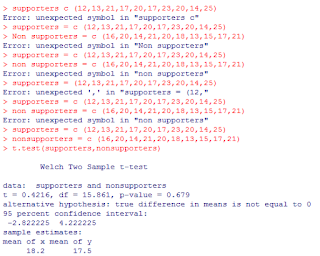Alright, so, I tried to follow along, but hit a road block with the codding. I’m really not sure where I went wrong as I copied and pasted straight from the blog.

Here is what I did gather about predictive analytics from the module and the blog. First off, it’s not easy. I am not sure if this would be true for all data or if this was particular to the stock market or just Apple stock in particular. I recall reading in the book “The Ascent of Money” by Niall Ferguson, about how a few people came up with a logarithm to crack the stock market. It worked…until it didn’t. That is to say that it worked for a while, only to have it fail as spectacularly as it once succeeded. Perhaps this is a testament to the limitations of predictive analytics; whether that is a permanent or temporary situation. Let’s say it was temporary. What then? What happens when the stock market gets cracked? This is an interesting thing to ponder. What happens when a system that is to such a high degree reactionary, gets predictable? Do we end up with one of those unstoppable forces V. the unmovable object scenarios? This isn’t a topic that has been discussed yet in any of my courses and perhaps I am getting ahead of myself, but I can’t help but wonder – how predictive can analytics get? And in situations where the prediction can affect the predicted; is that a bad thing?
Alight, back on task, here. The process by which the Apple stock was attempted to be predicted seemed pretty solid to me. Step one, gather the data. This part seems pretty straight forward and relatively easy as stock market data is regularly tracked and recorded. Once gathered, the data was narrowed down. This seems reasonable as the less data one has, the easier it is to work with. Choosing other stocks that seem to correlate with Apple, does not strike me as the plan though, as this can only be historical and could not account for future goings on. Furthermore, I one is going to go this route- why not just use the beta value, as this is common stat that can be obtained without any further analysis. The method of clustering did not yield stellar results. Perhaps this had to do with the lack of for cite when choosing the other stocks to cluster it with. The Linear Models also did not yield good results, as did the support vectors, and the classification trees. This all makes me wonder about what type of data is even the right type of data to yield productive analytics and what data should not even be attempted to be analyzed predictively. Perhaps that will be covered in the next class.


